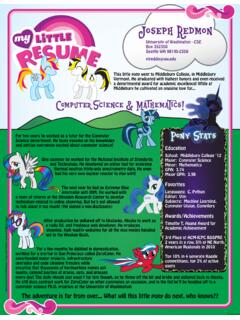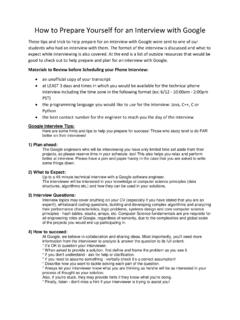Transcription of Writing the Academic CV - Pepperdine University
1 Writing the Academic CV SEAVER COLLEGE CAREER CENTER Pepperdine University Tyler Campus Center, Suite 210 (310) 506-4184 Seaver College Career Center Writing the Academic CV | page 1 Table of Contents Creating Your Components of a Helpful 10 Tips for Making an Sample SEAVER COLLEGE CAREER CENTER Pepperdine University Tyler Campus Center, Suite 210 (310) 506 - 4184 Seaver College Career Center Writing the Academic CV | page 2 Creating Your CV What is a CV? The curriculum vitae or CV can be translated as "the course of one's life/career and provides a comprehensive overview of your Academic background and professional accomplishments. A CV is often needed to apply to graduate programs , employment in academia or international organizations , and in certain professional fields . When to Use a curriculum vitae In the United States, a CV is used primarily when applying for Academic , scientific or research positions.
2 It is also applicable when applying for fellowships or grants. When asking for a job in Europe, the Middle East, Africa, or Asia, expect to submit a CV rather than a resume. Keep in mind that overseas employers often expect to read the type of personal information on a CV that would never be included on an American resume, such as date of birth, place of birth and nationality. An International CV also typically includes a personal photo as well. law regarding employment applications does not apply outside the country . This packet deals with Writing your Academic CV. For instructions on how to write an International CV, please see our International CV Guide. Resume vs. CV Many of the rules of Writing a resume can also be applied to Writing a CV. A CV is a longer and more detailed synopsis of your background and skills. The CV includes a greater range of information. Experience and Education dictate the length of your CV. A two to three page CV is common for most seniors and graduate students.
3 The focus is more on Academic achievements such as educational background and training, research interests, published works, teaching experience, field experience, Academic honors/awards, and other related professional experience. Like a resume, a CV should include your name, contact information, education, skills and experience. In addition, a CV includes research and teaching experience, publications, grants and fellowships, professional associations and licenses, awards and other information relevant to the position or program to which you are applying. Start by making a list of all your background information, and then organize it into categories. Make sure you include dates. Review CV Samples It's often helpful to look at samples before you begin Writing . In this packet you will find a guide for the important components of a CV. A sample student CV and sample CV template are also posted on our website: Seaver College Career Center Writing the Academic CV | page 3 The following components are important to include when Writing your CV: HEADINGS WITHIN A CV DESCRIPTION Personal Information Your contact information should be listed at the top of the first page and should include address, phone number(s), and email address.
4 In the footer of your CV, place your name on the left side and page number on the right side of all pages. Summary of Qualifications (or Achievements) Since the CV is often lengthy and more detailed than a resume, it is helpful to include a section that summarizes your most important skills and accomplishments. This can be written in paragraph or bullet-point format but should be limited to one concise paragraph or 5 bullet-points. Education (Include your thesis information here - coursework can be listed in a separate section) List your institution, degree, major or field of concentration, and date at which degree was received or will be completed. If relevant, include the title of your thesis and the name of your advisor here. You may include a brief description of your thesis and skills or methodology (if applicable) or attach an abstract of your thesis to the CV. You can list your classes in a separate section (called Relevant Coursework ) courses should be broken down into topic subsections and include the course title (not course number).
5 Experience (Can be listed in separate sections: Teaching Experience, Research Experience, Professional Experience, etc.) Describe all teaching, research, and professional work experience that is relevant to your professional objective. Only provide detail on experiences that are related to your professional objective. You can condense any unrelated professional experiences. Publications/Presentations (Can be listed in two separate sections) Any publications or presentations should be included on the CV. These should always be written in a bibliographical format. Items to be included under publications include books, articles, unpublished or forthcoming manuscripts, research papers or book chapters. Professional Affiliations These can be both scholarly and professional memberships in organizations. Any leadership roles should be stated. Honors/Awards/Grants (Can be listed in separate sections) List name of honor or award and the year it was received. You can list grants here or in a separate section.
6 Include the name of the funding agency and/or grant and the project(s) it is funding. References Name, title, organization/affiliation, relationship and contact information of people who have written letters of recommendation for you. Other sections that can be included : Community Involvement/Volunteer Experience, Technical Skills (Computer Skills), Travel/Exposure to Cultural Experiences, Foreign Language Skills, Research Interests Seaver College Career Center Writing the Academic CV | page 4 Other Things to Keep in Mind Important Notes: Your CV should be well organized and consistent. Be sure that all information is correctly lined up and organized in an effective manner. It is extremely important to make your CV as easy to read as possible. When Writing your CV, be descriptive and quantify when possible. Target your CV to each program or position to fully support your professional, Academic or research objective. Research the program or position that you are applying to so that your CV is relevant to the requirements of the program or position.
7 Proofread your CV more than once. Ask for help from your career counselor, advisor, Writing center and other colleagues. Look at examples of CVs on our website, in our Vault career library, and from faculty to get ideas for layout and content. Our website: Vault Library: Highlighting Your Thesis or Dissertation Including a one- or two- paragraph abstract of your thesis is recommended but optional. If you do provide an abstract, write (See Abstract Attached) in the Education section of your CV after the name of your thesis title. Writing your Thesis (or Dissertation) Abstract This should be included as a separate page at the end of the CV. Briefly summarize content, placing your work within its scholarly context, and noting its contribution to the field. Your abstract should be: Comprehensible to people outside your field Scholarly enough to interest people in your field Indicate if your dissertation is published in ProQuest UMI Dissertation database Seaver College Career Center Writing the Academic CV | page 5 10 Top Tips to Ensure Your CV Has IMPACT Adapted from TIP 1: Target your CV Prospective employers/programs are concerned with finding the right candidate.
8 Consider carefully the requirements of your target job or graduate program and make sure your CV highlights the relevant skills and experience. TIP 2: Structure your CV so it is easy to read An initial scan of a CV is usually only 20 or 30 seconds , so have your information clearly laid out with the most relevant skills and experience highlighted. Use headings and sub-headings to divide information and keep the format crisp. TIP 3: Create content that sells A good design will get attention, but it's really the content of your CV that determines your success. Provide plenty of information to help sell your skills and experience. Give concise descriptions of your roles and responsibilities, including key information such as research experience, publications, teaching experience, class projects and fieldwork/ internship experience. TIP 4: Focus on achievements and contributions Highlighting your relevant skills and achievements will really put you ahead of the competition.
9 Use active verbs to showcase your experiences and accomplishments. TIP 5: Quantify and qualify your achievements Create powerful success statements by quantifying your achievements. Give an indication of the scale and scope of your contributions by including details of the numbers of people/sites involved in particular projects. Highlight any special features, first research investigation in this field. TIP 6: Use strong marketing power words Use power words in your statements such as: achieved, delivered, led, implemented, pioneered, introduced, initiated, increased, improved. See our Action Verbs guide for more active verb choices. TIP 7: Sell the benefits of your skills Many CVs provide a list of duties without explaining the benefit of those skills. If one of your key skills is the ability to motivate teams, explain how this has benefited your employer's bottom line-- you have improved team morale and motivation, resulting in increased staff retention which has in turn reduced recruitment costs.
10 TIP 8: Provide examples to support your claims If you claim to be a good communicator, for instance, support this by providing information on the types and levels of people/organizations you've dealt with and how you have communicated. Example: Delivered presentations to audiences of up to 500 people. TIP 9: Ensure perfect presentation Poor presentation can undermine the best content, so make sure your spelling, grammar and layout are PERFECT . Be sure to proofread and have someone else read your CV to double check for errors. TIP 10: Keep your CV highly relevant and concise A successful CV is relevant and targeted to a specific program or position, so you should only include information which supports your suitability for the role. There are no right or wrong CV formats so re-order your CV to highlight experience most relevant to your current target. Sample curriculum vitae Headings Seaver College Career Center Writing the Academic CV | page 6 CONTACT INFORMATION Name (bold and larger font than the rest of the CV) Mailing Address Phone Number Email SUMMARY STATEMENT (Optional) Include a brief list of the highlights of your candidacy.








![Abstract arXiv:2107.06278v2 [cs.CV] 31 Oct 2021](/cache/preview/d/0/3/c/1/4/1/b/thumb-d03c141b31b29476ec074e3c5409c25c.jpg)
